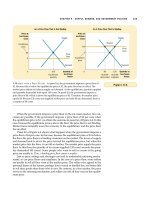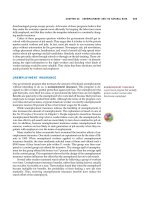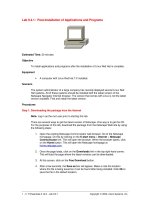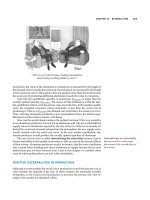Tài liệu AACN Essentials of Critical Care Nursing_1 doc
Bạn đang xem bản rút gọn của tài liệu. Xem và tải ngay bản đầy đủ của tài liệu tại đây (36.9 MB, 408 trang )
AACN
Essentials
of
Critical
Care
Nursing
Marianne
Chulay
,
AN
,
ONSc
,
FAAN
Consultant,
Critical
Care
Nursing
and
Clinical
Research
Chapel
Hill,
North
Carolina
Suzanne
M.
Burns
,
RN
,
MSN
,
ART
,
ACNP
,
CCRN
,
FAAN
,
FCCM
Professor
of
Nursing.
Acute
and
Specialty
Care
School
of
Nursing
Advanced
Practice
Nurse
Level
2.
Medicine/Medical
Intensive
Care
Unit
Universily
of
Virginia
Health
System
Charlottesville,
Virginia
McGraw-Hill
Medical
Publishing
Division
New
York
Chicago
San
Francisco
lisbon
London
Ma
dr
id
Mexico
City
M
il
an
New
Oe
lh1
San
Juan
Seoul
Singapore
S
ydney
Toronto
The
McGrow
·
Hi/1
Companies ·
AACN Essentials
of
Critkal
Care
Nursing
Copyright I!) 2006 by The McGra\\ -Hill
Companie~.
Inc. All
righh
reserved. Printed in the United
State~
of
Am.,rica.
E~cept
a'
pcrrnitt~
d
under the Unit"d Stat.:' Copyright Act
of
1976. no part of this publication
may
be
repm
Ju~.:J
ur
di,trib
utctl in any ltmn
ur
by an) mean
,,
ur
Mored in a data
bu
~e
or
retrieval ')l>tem. without the
prior written
~rmio;,ion
of
the publi,her.
3
~
5 6 7 K 9 0
QPD/QPD
0 9 I! 7
ISBN 0-07-1-'4771·7
NOTICE
M.:Jicin~
j,
an
ever-~:hanging
s~:ience.
A>
new
research
anJ
clinical
experience
broaden
our
knowkdge.
change!'> in trt!atment
and
drug
therapy are
required.
The
author
s
and
The
publisher
of
this
work
ha\
'C •·heckcd
with
'ourcc
s
believed
to
be
reliable
in
their
effons
to
provide
information
that is
complete
and
generally
in
accord
w
ith
the
sta
ndard
'
accepted
at
the
time
of
publication.
However.
in
view
of
the
possibility
of
human
error
or
changes
in
medical
sciences.
neither
the
author'
nor
the
publi~her
nor
any
other
par1y
who
ha~
been
involved
in
the
preparation
or
publication
of
this
work
warrant'
that
tbe
information
.:onrained
herein
is in
.:very
respect
a.:cunue
or complet.:. a
nd
the}
di ~
claim
all
respon•ihility
for
any
errors
or
omis~ion~
or
for
the
results
obtained
from
use
of
the
infom1ativn
contained
in
thi'
work.
Reader~
ar.:
encouraged
to
confirm
the
infonnation
contained
herein Y.ith
other
snun:es
.
For
cx.ample
and
in par1icular.
readers
are advis
ed
to
check
the
product
infom1ation
:.
heel
included
in
the
package
of
each
dmg
they
plan
to
administer
to
be
cenain
that
the
infonnation
contained
in
this
work
is
accurate
and
that
changes
have
not
been
made
in
the
re
c
ommended
dose
or
in
the
contraindication,.
for
administration.
This
recommendation
i~
of
pani.:ular
impor1ancc
in
connection
with
ne\\
or
infrequently
used
drugs.
Thi'
book
wa'
'et
in
Time'
Ruman
by
Mid-Atlantic Book" and
Joumab.
Inc.
The editor
wa'
Mi~hacl
Brown.
The
production
>Upef\
i~or
wa~
Sherri Souffmnce.
Project
manag~m<!nt
\loa' provided
b}
Jennsin S.:rvices.
Quebecur World Dutlu4ue
wa'
pnntcr and bimler.
Thi~
lxx>k
i~
printed on acid-free paper.
PlcJ't:
tell the author and publi,her what you think
••f
thi, book hy ;;ending your
comment~
to
nursing@mcgraw·
tl
i
ll
.cum.
Plc.I~C
put the authur and title ul th" bonk in the •utlject line.
Library
nr
Cnng
n., ~
Cata
lo~:inJ!·in-Puhlication
Data
AACN
e~'ential'
of
crittcal care I [cJitcd hy] Marianne Chula}. SuLanne M.
Bum,
I
't
t'd.
p.
;wt
.
Include' bibliographical
ref~r.!ncc'
and
indl.":\.
ISBN
0·07·
1-'4771· 7 1 ,uftcnvcr)
I.
Intensive .:are nursint:
{)
utlinc,.
~)llabi
.
etc. I. Title: American A"<x:iation
of
Critical-Care
Nuf'e'
e~
s
entiah
of
critical care nur-ing. II. Title:
E'~ential'
of
critical care
nursing.
Ill. Chulay. Marianne. IV.
Bum,,
Sutanne
M.
V.
American
A
~sociation
of
Critical-Care
Nur~'
-
!D
NLM: I. Critical Can:.
2.
Criticallllne~~-nursing.
3.
Nursing Care.
WY
154
All
I
~005]
RTI20.15AI65
~005
610
.73 .6 tk:22
2005041
551
To
our critical care nursing colleagues around the world
whose wondeiful work and efforts ensure the safe passage
of
patients
through the critical care environment.
Contributors
Reviewers
Preface
.
XV
.
xvii
.
••••• •
~
Section
I.
The
Essentials
!
I. Assessment
of
Critically Ill Patients and Families 3
Mary Fran Tracy
2.
Planning Care for Critically
Ill
Patients and Families .
.
17
Mary
Fran
Trac_v
3. Interpretation and Management
of
Basic Cardiac Rhythms .
.
·················· 37
Carol Jacobson
4. He1nodynamic Monitoring
65
Lewzna
R.
Miller
5. Airway and Ventilatory Management
111
Robert
E.
St. John
6.
Pain, Sedation, and Neuromuscular Blockade Management
Joan Michiko Ching
and
Suzanne
M.
Burns
145
7.
Pharmacology
165
Earnest Alexander
8.
Ethical and Legal Considerations. . ·············· 199
Juanita Reigle
Section
II.
Pathologic
Conditions
213
9.
Cardiovascular System
.
215
Barbara Leeper
10.
Respiratory System 247
Marianne Chulay
II.
Multisystem Problems .
Ruth
M.
K/einpe/1
12.
Neurologic Systern
Dea Ivfahanes
············· ·············································· 267
279
v
vi
CONTENTS
13.
Hematology and Immunology Systems 305
Diane
K.
Dressler
14.
Gastrointestinal System 317
Joanne Krumberger, Carol Rees Parrish, and Joe Krenitsky
15.
Renal
System
.
341
Carol Hinki e
16.
Endocrine System .
. 357
Joanne Krumberger
17.
Trauma
371
Jamie
B.
Sinks and Carol A. Rauen
SECTION
Ill:
Advanced
Concepts
in
Caring
for
the
Critically
Ill
Patient
389
18.
Advanced ECG Concepts
391
Carol Jacobson
19.
Advanced Cardiovascular Concepts
.431
Barbara Leeper
20. Advanced Respiratory Concepts .463
Suzanne
M.
Burns
21. Advanced Neurologic Concepts .477
Dea Mahanes
SECTION
IV:
Key
Reference
Information
50 1
22.
Normal Values Table 503
Marianne Chulay
23. Pharmacology Tables .505
Earnest Alexander
24. Advanced Cardiac Life Support Algorithms 519
Marianne Chulay
25.
Guidelines for the Transfer
of
Critically Ill Patients 529
Marianne Chulay
26. Hemodynamic Monitoring Troubleshooting Guide 533
Leanna
R.
Miller
27.
Ventilatory Troubleshooting Guide 539
Robert
E.
St.
John and Suzanne
M.
Bums
28. Cardiac Rhythms, ECG Characteristics, and Treatment Guide
551
Carol Jacobson
lndex
56!
Contents
in
Detail
Contributors
.
xv
Reviewers
.
xvii
Preface
xix
Section
I.
The
Essentials
!
I. Assessment
of
Critically Ill Patients and Families 3
Mar_v
Fran
Tracy
Assessment Framework 3
Prean-ival Assessment 4 I Admission Quick Check
4/
Comprehensive Admission Assessment
4/
Ongoing Assessment 4
Prearrival Assessment: Before the Action Begins 4
Admission Quick Check Assessment: The First Few Minutes 5
Airway and Breathing
6/
Circulation and Cerebral Perfusion
6/
Chief Complaint
6/
Drugs and Diagnostic Tests
6/
Equipment 7
Comprehensive Admission Assessment 7
Past Medical History 8 I Social History 8 I Physical Assessment by Body System 9 I
Psychosocial Assessment
12
Ongoing Assessment
14
2.
Planning Care for Critically Ill Patients and Families
17
Mary Fran
Trac.v
Multidisciplinary Plan of Care and Critical Pathways
17
Prevention
of
Common Complications
18
Physiologic Instability 18 I Deep Venous Thrombosis IS I Hospital-Acquired infections 23 I
Skin Breakdown 24 I Sleep Pattern Disturbances 24 I Psychosocial lmpact 25
Patient and Family Education 26
Assessment
of
Learning Readiness 26 I Strategies to Address Patient and Family Education
27
I
Outcome Measurement
27
Family-Focused Care 28
Transporting the Critically Ill Patient
29
Assessment
of
Risk for Complications 29 I Level
of
Care Required During Transport 30 I
Preparation
31
I Transport
31
I
Inteti~cility
Transfers 32
Transitioning to the Next Stage of Care 32
Supporting Patients and Families During the Dying Process 33
3.
Interpretation and Management of Basic Cardiac Rhythms .
Carol Jacobson
Basic Electrophysiology 37
.
37
vii
viii
CONTENTS
JN
DETAIL
ECG Waveforms, Complexes, and Intervals 38
P Wave
38/
QRS Complex
38/
T and U Waves
381
ST Segment 381 PR lnterva!
38/
QT
Interval 39
Cardiac Monitoring
39
Determination of the
Hem1
Rate 42
Determination
of
the
Cardiac
Rhythm
42
Common Arrhythmias 43
Rhythms Originating
in
the Sinus Node 43
Sinus Bradycardia
44/
Sinus Tachycardia
44/
Sinus Arrhythmia
451
Sinus Arrest 45
Arrhythmias Originating
in
the Atria 45
Premature Atrial Complexes
461
Wandering Atrial Pacemaker
46/
Atrial Tachycardia 47 I
Atrial Flutter 47 I Atrial Fibrillation 48
Arrhythmias Originating in the Atrioventricular Junction 49
Premature Junctional Complexes 50 I Junctional Rhythm, Accelerated Junctional Rhythm,
and Junctional Tachycardia 50
Arrhythmias Originating
in
the Ventricles
50
Premature Ventricular Complexes
51
I Ventri<:ular Rhythm and Accelerated Ventricular Rhythm
51/
Ventricular Tachycardia
52/
Ventricular Fibrillation
53/
Ventricular Asystole 53
Atrioventricular Blocks 54
First-Degree Atrioventricular Block 54 I Second-Degree Atrioventricular Block
54/
High-Grade
Atrioventricular Block
56/
Third-Degree Atrioventricular Block (Complete Block) 56
Temporary Pacing 57
Indications 57 I Trans venous Pacing
57
I Epicardial Pacing 57 I Components
of
a Pacing System 57 I
Basics
of
Pacemaker Operation 58 I ECG Characteristics
of
Paced Rhythms 60 I Initiating
Transvenous Ventricular Pacing 60
I Initiating Epicardial Pacing 60 I External (Transcutaneous)
Pacemakers 60
Defibrillation and Cardioversion 60
Defibrillation 60 I Automatic External Defibrillators
61
I Cardioversion 62
4.
Hemodynaznic Monitoring .
65
Lemma
R.
Miller
Hemodynamic Parameters
65
Cardiac Output
65/
Components
of
Cardiac Output/Cardiac Index 67 I Stroke Volume and Stroke
Volume Index 68
I Factors
Affc~.:ting
Stroke Volume/Stroke Volume Index 68
Basic Components
of
Hemodynamic Monitoring Systems 72
Pulmonary Artery Catheter 721 Arterial Catheter 72 I Pressure Tubing 721 Pressure Transducer
73
I
Pressure Amplifier
74/
Pressure Bag and Flush Device
74/
Alarms 74
Obtaining Accurate Hemodynamic Values 74
Zeroing the Transducer
74/
Leveling the Transducer
to
the Catheter Tip
75/
Calibration
of
the
Transducer/Amplifier
System77/
Ensuring Accurate Waveform Transmission 77
Insertion and Removal
of
Catheters 77
Pulmonary Artery Catheters 77 I Arterial Catheters 80
Obtaining and Interpreting Hemodynamic Waveforms
84
Patient Positioning 84 I Interpretation 84 I Artifacts
in
Hemodynamic Waveforms: Respiratory
Influence
91/
Cardiac Output 92
Continuous Mixed Venous Oxygen Monitoring
97
Svo
2
Monitoring Principles 97 I Selected Examples
of
Clinical Applications 98
Right Ventricular Ejection Fraction Catheters 99
Monitoring Prindp!es
99/
Troubleshooting 99
Minimally Invasive Hemodynamic Monitoring I 00
Thoracic Bioimpedance I 00 I Esophageal Doppler Cardiac Output I 00 I Carbon Dioxide
Rebreathing
JOO
I Gastric Tonometry 100 I Sublingual Capnometry
lOI
Application
of
Hemodynamic Parameters l 02
Low Cardiac Output States I 02 I High Cardiac Output States I 06
COfHENTS
IN
DETAIL
ix
5
A.irway
and Ventilatory Manage1nent
Ill
Robert
E.
St.
John
Respiratory Assessment Techniques. Diagnostic Tests. and Monitoring Systems
111
Arterial Blood Gas Monitoring
Ill
I Analysis 112 I Venous Blood Gas Monitoring 116 I Pulse
Oximetry 116
I Assessing Pulmonary Function I
18
Airway Management 118
Oropharyngeal Airway
118/
Nasopharyngeal Airway 120 I Artiflcial Airways 120
Oxygen Therapy 125
Complications
125
I Oxygen Delivery
127
Basic Ventilatory Management 129
Indications
129
I General Principles 129 I Modes
132
I Complic<Hions !
35
I Weaning From
Short-Term Mechanical Ventilation
136/
Troubleshooting Ventilators
138/
Communication
139
I
Principles
of
Management
141
6. Pain, Sedation, and Neuromuscular Blockade Management 145
Joan Michiko Ching
and
Suzanne
M.
Bums
Physiologic Mechanisms of Pain
145
Peripheral Mechanisms
145/
Spinal Cord Integration
147/
Central
Proces~ing
147
Responses to Pain 147
Pain Assessment 148
A Multilevel Approach to Pain Management 148
Nonsteroidal Anti-Inflammatory
DIUgs
149
Side
Effects
!50
Opioids !50
Side Effects 1
SO
I Intravenous Opioids
151
I Patient-Controlled Analgesia 1
S!
I Switching From
IV
to Oral Opioid Analgesia 152
Epidural Analgesia
153
Epidural Opioids
153/
Epidural Local Anesthetics 154
Cutaneous Stimulation 155
Distraction
155
Imagery 155
Relaxation and Sedation Techniques 155
Deep Breathing and Progressive Relaxation
156/
Presence
156
Special Considerations for Pain Management in the Elderly 156
Assessment
157
/Interventions
157
Sedation J
57
Reasons for Sedation
157/
Drugs for Sedation
158/
Goals
of
Sedation. Monitoring,
<md
Management
159/
Sedation Scales: Goals and Monitoring 159 I Sedation Management 159
Neuromuscular Blockade 159
Neuromuscular Blocking Agents
160
I Monitoring and Management
161
7.
Pharmacology
165
Earnest Alexander
Medication Administration Methods 165
Intravenous
165/
Intramuscular
or
Subcutaneous
165
I Sublingual
166/
Intranasal
166/
Transdennal 166
Central Nervous System Pharmacology 167
Sedatives 167 I Analgesics 170 I Neuromuscular Blocking Agents
171
I Anticonvulsants
173
Cardiovascular System Pharmacology J 76
Miscellaneous Agents
176/
Parenteral Vasodilators
177
I Antiarrhythmics J 80 I Thrombolytic
Agents
182/
Vasoconstricting Agents
183
/Inotropic Agents 184 I Activated Protein C 1
85
Anti-Infective Pharmacology
185
Aminoglycosides
185
I Vancomycin
186/
Other Antibiotics 186
X
CONTENTS
IN
DETAIL
Pulmonary Pharmacology
187
Theophylline
187
I
Albuterol
187
Gastrointestinal
Pharmacology
188
Stress Ulcer Prophylaxis
188
I Acute Peptic Ulcer Bleeding
189
I Variceal Hemorrhage
189
Renal Phannacology 190
Diuretics
190
Hematologic
Pharmacology
191
Anticoagulants
191
I Direct Thrombin Inhibitors I 93 I Glycoprotein IIb/IIa Inhibitor
193
Immunosuppressive
Agents
193
Cyclosporine
193
I Tacrolimus (FK506)
194
I Sirolimus (Rapamycin)
194
Special
Dosing
Considerations
195
Continuous Renal Replacement Therapy !95
I Drug Disposition
in
the Elderly
195
I Therapeutic
Drug Monitoring
195
8.
Ethical
and
Legal Considerations 199
Juanita Reigle
The
Foundation
for
Ethical
Decision
Making
199
Professional Codes and Standards
199
I Position Statement and Guidelines 200 /Institutional
Policies 200
I Legal Standards 200 I Principles of Ethics
201/
Care 2031 Patient Advocacy 204
The Process
of
Ethical Analysis 204
Assessment 2041 Plan
204/
Implementation 205 I Evaluation 205
Contemporary Ethical Issues 205
Informed Consent 2051 Determining Capacity
205/
Advance Directives
206/
End-of-Life
Issues 207
I Resuscitation Decisions 209
Building
an
Ethical
Environment
209
Values Clarification 209 I Provide Information and Clarify Issues 209 I Recognize Moral
Distress 210 I Engage in Collaborative Decision Making 210
Section
II.
Pathologic
Conditions
213
9.
Cardiovascular System .
Barbara
Leeper
Special
Assessment
Techniques,
Diagnostic
Tests,
and
Monitoring
Systems
215
Assessment of Chest Pain 215 I Coronary Angiography 215 I Percutaneous Coronary
Interventions
216/
Other Percutaneous Coronary Interventions 217
Pathologic Conditions 218
215
Acute Ischemic Heart Disease 218 I Congestive Heart Failure 230 I Shock
238/
Hypertension 243
I
0.
Respiratory System 247
Marianne Chulay
Special
Assessment
Techniques,
Diagnostic
Tests,
and
Monitoring
Systems
247
Chest X-Rays 247 I Computed Tomography and Magnetic Resonance Imaging
251
I
Chest Tubes 252
Pathologic
Conditions
252
Acute Respiratory Failure 252 I Acute Respiratory Distress Syndrome 256 I Acute Respiratofy
Failure in the Patient With Chronic Obstructive Pulmonary Disease 258
I Pneumonia 260 I
Pulmonary Embolism 263
II.
Multisystem Problems 267
Ruth
M.
Kleinpel/
Pathologic Conditions 267
Sepsis and Multiple Organ Dysfunction Syndrome 267
Overdoses 274
Etiology, Risk Factors, and Pathophysiology 274
CONTENTS
IN
DETAIL
xi
12.
Neurologic System 279
DeaMahanes
Assessment Techniques 279
Level
of
Consciousness 279 I Glasgow Coma Scale 280 I Mental Status
281
I Motor Assessment
283
I Sensation 283 I Cranial Nerve Assessment and Assessment
of
Brainstem Function 285 I Vital
Sign Alterations
in
Neurologic Dysfunction 286 I Death by Neurologic Criteria 287
Diagnostic
Testing
287
Lumbar Puncture 287 I Computed Tomography 288 I Magnetic Resonance Imaging 288 I Cerebral
Angiography 289
I Transcranial Doppler Ultrasound 290 I Electroencephalography 290 I
Electromyography 290
Intracranial
Pressure:
Concepts
and
Monitoring
290
Cerebral Blood Flow
291
I Causes
of
Increased Intracranial Pressure
291
Acute Ischemic Stroke 296
Etiology, Risk Factors, and Pathophysiology 296 I Diagnostic Tests 297
Hemorrhagic Stroke 299
Etiology, Risk Factors, and Pathophysiology 299 I Clinical Presentation 300 I Diagnostic Tests 300 I
Principles
of
Management
of
Intracerebral Hemorrhage 300
Seizures 300
Etiology, Risk Factors, and Pathophy1>iology 300 I Clinical Presentation 300 I Principles
of
Management
of
Seizures 30 I
Infections
of
the Central Nervous System 302
Meningitis 302 I Encephalitis
302/
Intracranial Abscess 302
Neuromuscular Diseases 303
Myasthenia Gravis
303/
Guillain-Barre Syndrome 303
13.
Hematology and Immunology Systems .305
Diane
K.
Dressler
Special
Assessment
Techniques,
Diagnostic
Tests,
and
Monitoring
Systems
305
Complete
Blood
Count
305
I
Red
Blood
Cell
Count
305
I
Hemoglobin
3061 Hematocrit 3061
Red
Blood
Cell
Indices
3061
Total
White
Blood
Cell
Count 3061
White
Blood
Cell
Differential 306 I Platelet Count 307 I Erythrocyte Sedimentation Rate 307 I Coagulation
Studies 307
I Additional Tests and Procedures 308
Pathologic Conditions 308
Anemia
308/
Immunocomprornise 310 I Coagulopathies 312
14.
Gastrointestinal System 317
Joanne Krumberger, Carol Rees Parrish, and Joe Krenitsky
Pathologic
Conditions
317
Acute Upper Gastrointestinal Bleeding 317 I Liver Failure 325 I Acute Pancreatitis 330 I
Bowel Infarction/Obstruction
331
Nutritional Support for Critically Ill Patienl' 332
Nutrition Needs
332/
Residual Volume 333 I Aspiration
334/
Bowel Sounds
335/
Nausea and
Vomiting 336
I Osmolality
or
Hypertonicity
of
Formula 3361 Diarrhea 337 I Flow Rates and Hours
of
Infusion 337 I Formula Selection 337
15.
Renal System .341
Carol Hinkle
Special
Assessment
Techniques,
Diagnostic
Tests,
and
Monitoring
Systems
341
Pathologic
Conditions
341
Acute
Renal
Failure
341 I
Life-Threatening
Electrolyte
Imbalances
346
Renal Replacement Therapy 350
Access
351
I DialyzeriHemofilters/Dialysate 352 I Procedures 352 I Indications for and Efficacy
of
Renal Replacement Therapy Modes
352/
General Renal Replacement Therapy Interventions 355
Xii
CONTENTS
IN
DETAIL
16.
Endocrine System 357
Joanne Krwnberger
Special Assessment Techniques, Diagnostic Tests, and Monitoring Systems 357
Blood Glucose Monitoring 357
Pathologic Conditions 359
Hyperglycemic Emergencies
359/
Acute Hypoglycemia
364/
Syndrome
of
Inappropriate
Antidiuretic Honnone Secretion 365
I Diabetes Insipidus 367
17.
Trauma .371
Carol A. Rauen
and
Jamie
B.
Sinks
Specialized Assessment Techniques, Diagnostic Tests, and Monitoring Systems 371
Primary and Secondary Trauma Survey Assessment
371
I Diagnostic Studies
374/
Mechanism
of
Injury
376/
Physiologic Consequences
of
Trauma 377
Common
Injuries
in
the Critically Ill
Trauma
Patient 378
Thoracic Trauma 378 I Abdominal Trauma 380 I Musculoskeletal Trauma
381
Complications
of
Traumatic Injury in Severe Multisystem
Trauma
382
Acute Respiratory Distress Syndrome
384/
Infection/Sepsis
385/
Systemic Inflammatory
Response Syndrome 385
Psychological Consequences
of
Trauma
385
Section
Ill.
Advanced
Concepts
in
Caring
for
the
Critically
Ill
Patient.
. 389
18.
Advanced ECG Concepts
391
Carol Jacobson
The
12-Lead
Electrocardiogram
39l
Axis Determination
396/
Bundle Branch Block
399/
Myocardial Ischemia, Injury,
and Infarction
4011 Preexcitation Syndromes 407
Advanced Arrhythmia Interpretation 411
Supraventricular Tachycardias
412/
Differentiating Wide QRS Beats and Rhythms 415
ST-Segment Monitoring
419
Measuring the
ST
Segment 420 I Choosing the Best Leads forST-Segment Monitoring
421
Cardiac
Pacemakers
418
Evaluating Pacemaker Function
423/
VY1
Pacemaker Evaluation
423/
DDD Pacemaker
Evaluation 427
19. Advanced Cardiovascular Concepts .431
Barbara Leeper
Pathologic Conditions 431
Cardiomyopathy 431 I Valvular Disease 4361 Pericarditis 441 I Aortic Aneurysm 4431 Cardiac
Transplantation
446/
Intra-Aortic Balloon Pump Therapy 4521 Ventricular Assist Devices 455
20. Advanced Respiratory Concepts .463
Suzanne
M.
Burns
Advanced Modes
of
Mechanical Ventilation 463
New Concepts: Mechanical Ventilation
4631
Volume Versus Pressure Ventilator
464/
Alternative
Ventilator Options 469
Weaning Patie.nts From Long-Term
Mechanical
Ventilation
470
Wean Assessment 470 I Wean Planning
471
I Weaning Trials, Modes, and Methods
471
I
Respiratory Fatigue, Rest, and Conditioning
471/
Wean Trial Protocols 4721 Other Protocols for
Use
473/
Critical Pathways
473/
Systematic Institutional Initiatives for the Management
of
the
LTMV Patient Population 473
21. Advanced Neurologic Concepts .477
Dea Mahanes
Subarachnoid
Hemorrhage
477
Etiology. Risk Factors, and Pathophysiology 477 I Clinical Presentation 477 I Diagnostic Tests 479
Traumatic Brain Injury
481
Etiology, Risk Factors, and Pathophysiology
4811
Clinical Presentation 4851 Diagnostic Tests 485
Traumatic Spinal Cord Injury 487
Etiology, Risk Factors, and Pathophysiology 487 I Clinical Presentation
489/
Diagnostic Tests 490 I
Future Spinal Cord Injury Treatment 490
Brain
Tumors
494
Etiology, Risk Factors, and Pathophysiology
4941
Diagnostic Tests 495 I Advanced Technology:
Brain
Tissue Oxygen Monitoring 497
Section
IV.
Key
Reference
Information.
CONTENTS
IN
DETAIL
Xiii
.501
22. Nonnal Values Table 503
lvlarianne Chulay
23. Pharmacology Tables 505
Earnest A!ex(lnder
24. Advanced Cardiac Life Support Algorithms 519
25.
Marianne Chulay
Guidelines for the Transfer
of
Critically
Ill
Patients.
Marianne Chulay
Transfers Within the Hospital 529
···············
.529
Transport Personnel 529 I Transpm1 Equipment Requirements 529 I Monitoring During
Transfer 529
I Pretransfer Coordination and Communication 529
Transfers Between Hospitals 530
Transport Personnel 530 I Transport Medication Requirements
530
I Transfer Equipment 530 I
Monitoring During Transfer
531
I Transfer Algorithm 532
26.
Hemodynamic
Monitoring
Troubleshooting Guide
.,
533
Lear111a
R.
Miller
27. Ventilatory Troubleshooting Guide 539
Robert
E.
St. John
and
Suzanne
M.
Burns
28. Cardiac Rhythms, ECG
Characteristics.
and
Treatment
Guide
551
Carol
Jacobson
Index
. 561
Acknowledgments
Special thanks to those who made contributions to the predecessor
of
this book,
AACN
Handbook
of
Critical Care Nursing,
To Cathie Guzzetta, RN, PhD, FAAN and Barbie Dossey, RN, MS, FAAN for their editorial contributions and mentoring,
And to the following authors for their contributions to chapter content:
Tom Ahrens, RN, DNS, CS, FAAN (Chapters
4,
26)
Deb Byram, RN, MS (Chapter 1)
Anita Sherer, RN, MSN (Chapter 2)
Sue Simmons-Ailing, RN, MSN (Chapter 2)
Marlene Yates, RN, MSN (Chapter 2)
Susan Woods, PhD, RN (Chapters
3,
18)
Maria Connolly, RN, DNSc (Chapters
5,
10)
Lorie Wild, RN, PhD (Chapter 6)
Greg Susla, PharmD, FCCM (Chapters
7,
23)
Bradi Granger, RN, PhD (Chapter 9)
Debbie Tribett, RN, MS, CS, LNP (Chapter 13)
Karen Carlson, RN, MN (Chapter 15)
Dorie Fontaine, RN, DNSc, FAAN (Chapter 17)
Anne Marie Gregoire, RN, MSN, CRNP (Chapter 19)
Debra Lynn-McHale, RN, PhD, CS (Chapter 19)
Contributors
Earnest
Alexander,
PharmD
Critical Care Pharmacotherapy Specialist
Tampa General Hospital
Clinical Assistant Professor
University
of
Florida and Florida
A&M
University
Tampa, Florida
Chapter
7:
Pharmacology
Chapter 23: Pharmacology Tables
Suzanne
M.
Burns,
RN,
MSN,
RRT,
ACNP,
CCRN,
FAAN,FCCM
Professor
of
Nursing, Acute and Specialty Care
Advanced Practice Nurse Level 2, Medicine/Medical
Intensive Care Unit
School
of
Nursing
University
of
Virginia Health System
Charlottesville, Virginia
Chapter 6: Pain, Sedation,
and
Neuromuscular Blockade
Management
Chapter 20: Advanced Respiratory Concepts
Chapter 27: Ventilatory Troubleshooting Guide
Joan
Michiko
Ching,
RN,
MN
Clinical Faculty
University
of
Washington
Pain Management Clinical Nurse Specialist
University
of
Washington Medical Center
Seattle, Washington
Chapter
6:
Pain, Sedation, and Neurornuscular Blockade
Management
Marianne
Chulay,
RN,
DNSc,
FAAN
Consultant, Critical Care Nursing and Clinical Research
Chapel Hill, North Carolina
Chapter 10: Respiratory System
Chapter 22: Normal Values Table
Chapter 24: Advanced Cardiac Life Support Algorithms
Chapter 25: Guidelines
for
the Transfer
of
Critically Ill
Patients
Diane
K.
Dressler,
RN,
MSN,
CCRN
Clinical Assistant Professor
Marquette University College
of
Nursing
Milwaukee, Wisconsin
Chapter 13: Hematology
and
Immunology Systems
Carol
Hinkle,
RN,
MSN,
CCRN
Education
Consultant-Critical
Care
Education Department
Brookwood Medical Center
Birmingham, Alabama
Chapter 15: Renal System
Carol
Jacobson,
RN,
MN,
FACCN
III
Director, Quality Education Services
Per diem Clinical Nurse Specialist, Swedish Medical Center
Per diem Clinical Nurse Specialist, Children's Medical
Center
Seattle, Washington
Chapter
3,'
Interpretation
and
Management
of
Basic
Cardiac Rhythms
Chapter 18: Advanced ECG Concepts
Chapter 28: Cardiac Rhythms, ECG Characteristics,
and
Treatment Guide
Ruth
M.
Kleinpell,
PhD,
RN-CS,
FAAN,
ACNP,
CCRN
Associate Professor
Rush University College
of
Nursing
Chicago, Illinois
Chapter 11: Multisystem Problems
Joe
Krenitsky,
MS,
RD
Nutrition Support Specialist
Digestive Health Center
of
Excellence and Department
of
Nutrition Services
University
of
Virginia Health System
Charlottesville, Virginia
Chapter 14: Gastrointestinal System
XV
xvi
CONTRIBUTORS
Joanne
Krnmberger,
RN, MSN,
CHE,
FAAN
Manager, Performance Improvement
Milwaukee VA Medical Center
Milwaukee, Wisconsin
Chapter 14: Gastrointestinal System
Chapter
16:
Endocrh1e
System
Barbara
Leeper, MN, RN,
CCRN
Clinical Nurse Specialist, Cardiovascular Services
Baylor University Medical Center
Dallas, Texas
Chapter
9:
Cardiovascular
System
Chapter 19: Advanced Cardiovascular Concepts
Dea
Mahanes,
RN, MSN,
CCRN,
CNRN, CCNS
Advanced Practice Nurse Level
1,
Nerancy Neuro-
Intensive Care Unit
University
of
Virginia Health System
Charlottesville, Virginia
Chapter 12: Neurologic System
Chapter 21: Advanced Neurologic Concepts
Leanna
R. Miller, RN, MN,
CCRN,
CEN,
NP
Educator for Trauma, Burn, Neurocare, Flight
Vanderbilt University Medical Center
Nashville, Tennessee
Chapter 4: Hemodynamic Monitoring
Chapter 26: Hemodynamic Monitoring Troubleshooting
Guide
Carol
Rees
Parrish,
MS,
RD
Nutrition Support Specialist
Digestive Health Center of Excellence and
Department
of
Nutrition Services
University
of
Virginia Health System
Charlottesville, Virginia
Chapter
14:
Gastrointestinal System
Carol
A.
Ranen,
RN,
MS,
CCNS,
CCRN
Assistant Professor
School
of
Nursing & Health Studies
Georgetown University
Washington, DC
Lecturer
Barbara Clark Mims Associates
Dallas, Texas
Chapter 17: Trauma
Juanita
Reigle, RN, MSN,
ACNP
Associate Professor
of
Nursing, Acute and Specialty Care
Advanced Practice Nurse Level 2, Heart Center
School
of
Nursing
University
of
Virginia Health System
Charlottesville, Virginia
Chapter
& Ethical
and
Legal Considerations
Jamie
B. Sinks, RN,
MS
Trauma Resuscitation Nurse
MedSTAR
Washington Hospital Center
Washington, DC
Chapter
17:
Trauma
Robert
E.
St.
John,
MSN, RN,
RRT
Director Post-Market Clinical Research
Nellcor/Tyco Healthcare
Pleasanton, California
Chapter 5: Airway
and
Ventilatory Management
Chapter 27: Ventilatory Troubleshooting Guide
Mary
Fran
Tracy,
PhD,
RN,
CCRN,
CCNS, FAAN
Clitical Care Clinical Nurse Specialist
Fairview-University Medical Center
Minneapolis, Minnesota
Chapter
J:
Assessrnent
of
Critically Ill Patients and Families
Chapter
2:
Planning Care for Critically Ill Patients and
Families
Tom
Ahrens, DNS, RN, CS
Research Scientist
Barnes-Jewish Medical Center
St. Louis, Missouri
Mary
Kay
Bader,
RN, MSN,
CCRN,
CNRN
Neuro/Critical Care Clinical Nurse Specialist
Mission Hospital
Mission Viejo, California
Toni Balistrieri, RN, MSN,
CCRN
Clinical Nurse Specialist, Critical Care
Milwaukee
VA
Medical Center
Milwaukee, Wisconsin
Connie
Barden,
RN, MSN,
CCRN,
CCNS
Cardiovascular Clinical Nurse Specialist
Mercy Hospital
Miami, Florida
Debbie Barnes, RN, MSN
Clinical Practice Specialist
American Association of Ctitical Care Nurses
Aliso Viejo, California
Linda
Bell, RN,
MSN
Clinical Practice Specialist
American Association
of
Critical Care Nurses
Aliso Viejo, California
Liz Browne, RN
Clinician 3, Medical Intensive Care Unit
University
of
Virginia Health System
Charlottesville, Virginia
Sarah
Delgado, RN, MSN,
ACNP
Clinical Instructor
School
of
Nursing
University
of
Virginia
Charlottesville, Virginia
Reviewers
Charles
Fisher,
RN, MSN,
CCRN,
ACNP
Advanced Practice Nurse Level 1 Outcomes l\1anager,
Long-term Ventilated Patients
University
of
Virginia Health System
Charlottesville, Virginia
Lisa
W.
Forsyth,
RN,
MSN
Clinician 4, Clinical Educator
University
of
Virginia Health System
Charlottesville, Virginia
Ann
B.
Hamric,
PhD,
RN, FAAN
Associate Professor
School
of
Nursing
University
of
Virginia
Charlottesville, Virginia
Dave
Hanson,
MSN, RN,
CCRN
Clinical Nurse Specialist
JPS Health System
Ft. Worth. Texas
Rebecca H.
Hockman,
Pharm
DBCPS
Clinical Pharmacy Specialist. Medical Intensive Care Unit
University
of
Virginia Health System
Charlottesville, Virginia
Kimmith
M.
Jones,
RN,
MS
Advanced Practice Nurse/Clinical Nurse Specialist
Critical Care/Emergency Center
Sinai Hospital
of
Baltimore
Baltimore, Mary land
Kerry
Kosmoski-Goepfert, PhD, RN
Clinical Assistant Professor/Acute Care Nurse Practitioner
Option Coordinator
Marquette University
College
of
Nursing
Milwaukee, Wisconsin
xvii
XViii
REVIEWERS
Mary
Beth Flynn Makic, RN, MS, CNS, CCRN
Clinical Nurse Specialist/Educator and Senior Instructor
University
of
Colorado Hospital and University
of
Colorado
Health Sciences Center, School
of
Nursing
Denver,
Colorado
Mary
Marshall, RN, MSN
Clinical Research Coordinator
University
of
Virginia Health System
Charlottesville, Virginia
Laura
H. Mcilvoy, PhD, RN, CNRN, CCRN
Assistant Professor
University
of
Louisville School
of
Nursing
Louisville, Kentucky
Paul Merrel, RN, MSN, CCRN
Advanced Practice Nurse Level I, Outcomes Manager,
Long-term Ventilated
Patients
University
of
Virginia Health System
Charlottesville, Virginia
Sue Sendelback, PhD, RN, FAHA
Clinical Nurse Specialist
Abbott-Northwestern Hospital
St. Paul, Minnesota
Christine Shaw, PhD, APRN-BC
Clinical Associate Professor
Marquette University College
of
Nursing
College
of
Nursing
Milwaukee, Wisconsin
Cheri Smith, RN, BSN
Clinician 4, Medical Intensive Care Unit
University
of
Virginia Health System
Charlottesville, Virginia
Greg Susla, PharmD,
FCCM
Pharmacy Manager
VHA Consulting Services
Frederick, Maryland
Sherrie Walker, RD
Nutrition Support Specialist
University
of
Virginia Health System
Charlottesville, Virginia
Teresa
A.
Wavra, RN, MSN, CCRN, CCNS
Clinical Practice Specialist
American Association
of
Critical Care Nurses
Aliso Viejo, California
Lorie Wild, PhD, RN
Director, Patient Care Services
University
of
Washington Medical Center
Seattle, Washington
Susan L. Woods, PhD, RN, FAAN, FAHA
Professor and Associate Dean
University
of
Washington
School
of
Nursing
Seattle, Washington
Susan Yeager, MS, RN, CCRN, ACNP
Neuroscience Nurse Practitioner
Grant Riverside Methodist Hospital
Hillard, Ohio
Preface
Critical care nursing is a complex, challenging area
of
nurs-
ing practice, where clinical expertise is developed over time
by
integrating critical care knowledge, clinical skills, and
caring practices. Finding a textbook that comprehensively
yet succinctly presents essential information about
how
best
to safely and competently care for critically
ill
patients and
their families is a challenge for those charged with the edu-
cation
of
new critical care practitioners.
Most
current text-
books deal with critical care content
by
combining essential
and advanced concepts, rather than by providing the essen-
tial concepts first and introducing more advanced concepts
later. In-depth discussion
of
these advanced concepts, al-
though meaningful and important for advanced practitioners,
often overwhelms the novice practitioner.
Current
texts also include too much information
for
entry-level courses in critical
care
nursing
or
for use as a
review tool for the critical care certification (CCRN) exami-
nation. Orientation programs in most hospitals are extremely
short
(2
to
6 weeks), and undergraduate programs that provide
critical care content often do so in short elective courses, or
integrate the content into an advanced medical-surgical nurs-
ing course. Instructors are reluctant
to
suggest
or
require stu-
dents to buy expensive books that include more information
than they need at that time
or
that repeat material
that
appears in other student-owned textbooks (anatomy and
physiology, nursing diagnosis, non-critical care assessment.
medical diagnostic reasoning). Although clinicians may pur-
chase these books to prepare for certification examinations,
many would benefit from a more concise textbook and clin-
ical reference.
The
AACN
Essentials
r~j'Critical
Care Nursing provides
essential information on the
care
of
adult critically ill pa-
tients and families. The book recognizes the learner's need
to
assimilate foundational
knowledge
before attempting to
master more complex critical care nursing concepts. Writ-
ten by nationally acknowledged clinical experts in critical
care nursing, this handbook sets a new standard for critical
care nursing education.
The
AACN
Essentials
'~(Critical
Care Nursing repre-
sents a departure from the way in which most critical care
books are written because it
Succinctly presents essential information for the safe
and competent care
of
critically ill adult patients and
their families, building on the clinician's significant
medical-surgical nursing knowledge base, avoiding
repetition
of
previously acquired information.
Stages the introduction
of
advanced concepts
in
crit-
ical care nursing after essential concepts have been
mastered.
Presents practical approaches to patient and family
teaching when time
is
short and acuity
is
high.
• Provides clinicians with clinically relevant tools and
guides to use as they care for critically ill patients and
families.
TheAACN
Essentials
£~{Critical
Care Nursing
is
divided
into four sections:
Section/: The Essentials presents essential information
that new clinicians must understand to provide safe,
competent nursing care to all critically
ill
patients, re-
gardless
of
their underlying medical diagnoses. This
section includes content on essential concepts
of
as-
sessment. diagnosis. planning, and interventions com-
mon to critically
ill
patients and families: interpretation
and management
of
cardiac rhythms; hemodynamic
monitoring; airway and ventilatory management; phar-
macology; and pain management. Chapters
in
Section I
present content in enough depth to ensure that essen-
tial information
is
available for the new critical care
clinician to develop competence, while defen·ing more
advanced content to a later section
of
the handbook
(Section III).
Section
II:
Advanced Concepts covers pathologic con-
ditions and management strategies commonly en-
countered in medical and surgical critical care units,
xix
XX
PREFACE
closely paralleling the blueprint for the CCRN exam-
ination. Chapters in this section are organized by
body system (cardiovascular, respiratory, neurologic,
hematology and immunology, gastrointestinal, renal,
and endocrine) and include chapters on trauma and
multisystem problems. Case studies assist clinicians
in
understanding the magnitude
of
the pathologic prob-
lems and their impact on patients and families. Brief
descriptions of the pathophysiology, etiology, clinical
manifestations, diagnostic testing, and complications
associated with conditions presented
in
the case stud-
ies are provided. The focus
of
each pathologic pre-
sentation
is
the multidisciplinary management
of
key
patient needs and problems.
Section
1/1:
Advanced
Concepts
in
Caring
for
the
Critical(v Ill Patient
presents advanced critical care
concepts or pathologic conditions that are less com-
mon or more specialized than expected
in
general
medical-surgical critical care units. The format
of
this
section
is
identical to Section
II.
Section
IV:
Key R(ference
b~j(mnation
contains refer-
ence information that clinicians will lind helpful
in
the
clinical area (normal laboratory and diagnostic values;
algorithms for advanced cardiac life support; trou-
bleshooting guides for hemodynamic monitoring and
ventilator management; and summary tables of criti-
cal care drugs and cardiac rhythms). Content
is
pre-
sented primarily
in
table format for quick reference.
Each chapter begins with Knowledge Competencies that can
be used to guide informal or formal teaching and to gauge
the learner's progress. Case studies are presented
in
many
of
the chapters and can be read before proceeding with the
chapter to obtain
an
overall picture of the clinical problem, or
in
context with the chapter content
to
reinforce concepts. A
"Critical Thinking" case study concludes many of the chap-
ters to challenge the clinician to apply chapter information
to
a realistic clinical scenario.
\Ve believe that there
is
no
greater way to protect our
patients than to ensure that an educated clinician cares for
them. Safe passage
in
critical care
is
ensured by competent,
skilled, knowledgeable, and caring clinicians. We sincerely
believe that this textbook will help you make
it
so'
Marianne Chu/ay
Su::J
Burns
The
Essentials
One
of
Critically
Ill
Patients
and
Fami
I
ies
One
Mary Fran Tracy
,._
Knowledge
Competencies
1.
Discuss
the
importance
of
a
consistent
and
systematic
approach
to
assessment
of
critically
ill
patients
and
their
families.
•
Comprehensive
admission
assessment
•
Ongoing
assessment
3.
Describe
how
the
assessment
is
altered
based
on
the
patient'stlfn
ical
status.
2.
Identify
the
assessment
priorities
for
different
stages
of
a
critical
illness:
•
Prearrival
assessment
•
Admission
quickcheck
The assessment
of
critically ill patients and their families is
an essential competency for critical care practitioners. In-
formation obtained from an assessment identifies the imme-
diate and future needs
of
the patient and family so a plan
of
care can be initiated to address or resolve these needs.
Traditional approaches to patient assessment include a
complete evaluation
of
the patient's history and a comprehen-
sive physical examination
of
all body systems. This approach,
although ideal, rarely is possible in critical care
as
clinicians
struggle with life-threatening problems during admission and
must balance the need to gather data while simultaneously
prioritizing and providing care. Traditional approaches and
techniques for assessment must be modified in critical care
to balance the need for information, while considering the
critical nature
of
the patient and family's situation.
This chapter outlines an assessment approach that rec-
ognizes the emergent and dynamic nature
of
a critical ill-
ness. This approach emphasizes the collection
of
assessment
data in a phased, or staged, manner consistent with patient
care priorities. The components
of
the assessment can be
used as a generic template for assessing most critically ill
patients and families. The assessment can then be individu-
alized by adding more specific assessment requirements de-
pending on the specific patient diagnosis. These specific
components
of
the assessment are identified in subsequent
chapters.
Crucial to developing competence in assessing critically
ill patients and their families is a consistent and systematic
approach to assessments. Without this approach, it would be
easy to miss subtle signs or details that may identify an actual
or potential problem and also indicate a patient's changing
status. Assessments should focus first on the patient, then on
the technology. The patient needs to be the focal point
of
the
critical care practitioner's attention, with technology aug-
menting the information obtained from the direct assessment.
There are two standard approaches to assessing pa-
tients, the head-to-toe approach and the body systems ap-
proach. Most critical care nurses use a combination, a sys-
tems approach applied in a "top-to-bottom" manner. The
admission and ongoing assessment sections
of
this chapter
are presented with this combined approach in mind.
ASSESSMENT
FRAMEWORK
Assessing the critically ill patient and family begins from the
moment the nurse is made aware
of
the pending admission
of
the patient and continues until transitioning to the next
3
4
CHAPTER
1.
ASSESSMENT
OF
CRITICALLY
ILL
PATIENTS
AND
FAMILIES
phase
of
care. The assessment process can be viewed as four
distinct stages: prearrival, admission quick check ("just the
basics"), comprehensive admission, and ongoing assessment.
Prearrival
Assessment
A prearrival assessment begins the moment information is
received about the upcoming admission
of
the patient. This
notification comes from the initial health care team contact.
The contact may be paramedics in the field reporting to the
emergency department (ED), a transfer from another facil-
ity, or a transfer from other areas within the hospital such as
the emergency room (ER), operating room (OR), or medical/
surgical nursing unit. The prearrival assessment paints the
initial picture
of
the patient and allows the critical care nurse
to begin anticipating the patient's physiologic and psycho-
logical needs. This prearrival assessment also allows the crit-
ical care nurse to determine the appropriate resources that are
needed to care for the patient. The information received in
the prearrival phase is crucial because it allows the critical
care nurse to adequately prepare the environment to meet the
specialized needs
of
the patient and family.
Admission
Quick
Check
An admission quick check assessment is obtained immedi-
ately upon arrival and is based on assessing the parameters
represented by the ABCDE acronym (Table
1-1).
The ad-
mission quick check assessment is a quick overview
of
the
adequacy
of
ventilation and perfusion to ensure early in-
tervention for any life-threatening situations. Energy is also
focused on exploring the chief complaint and obtaining es-
sential diagnostic tests to supplement physical assessment
findings. The admission quick check is a high-level view
of
the patient, but is essential because it validates that basic car-
diac and respiratory function is sufficient.
Comprehensive
Admission
Assessment
A comprehensive admission assessment is performed as
soon
as
possible, with the timing dictated by the degree
of
physiologic stability and emergent treatment needs
of
the pa-
tient. The comprehensive assessment is an in-depth assess-
ment
of
the past medical and social history and a complete
physical examination
of
each body system. The comprehen-
sive assessment is vital to successful outcomes because
it
provides the nurse invaluable insight into proactive inter-
ventions that may be needed.
~~
~
w\
'·
~c,
\
\i""-
(}
v\
\
C\L
TABLE
1-1.
ABC
DE
ACRONYM
Airway
Breathing
Circulation,
Cerebral
perfusion,
and
Chief
complaint
Drugs
and
Diagnostic
tests
Equipment
"""'\
\
Ongoing
Assessment
After the baseline comprehensive assessment is completed,
ongoing assessments, an abbreviated version
of
the compre-
hensive admission assessment, are performed at varying in-
tervals. The assessment parameters outlined in this section
are usually completed for all patients, in addition to other on-
going assessment requirements related to the patient's spe-
cific condition, treatments, and response to therapy.
PREARRIVAL
ASSESSMENT:
BEFORE
THE
ACTION
BEGINS
A prearrival assessment begins when information is received
about the pending arrival
of
the patient. The prearrival re-
port, although abbreviated, provides key information about
the chief complaint, diagnosis, or reason for admission, per-
tinent history details, and physiologic stability
of
the patient
(Table 1-2). It also contains the gender and age
of
the patient
and information on the presence
of
invasive tubes and lines,
medications being administered, other ongoing treatments,
and pending or completed laboratory or diagnostic tests. It
TABLE
1-2.
SUMMARY
OF
PREARRIVAl
AND
ADMISSION
QUICK
CHECK
ASSESSMENTS
Prearrival
Assessment
•
Abbreviated
report
on
patient
(age,
sex,
chief
complaint,
diagnosis,
pertinent
history,
physiologic
status,
invasive
devices.
equipment
and
status
of
laboratory/diagnostic
tests)
•
Room
setup
complete,
including
verification
of
proper
equipment
functioning
Admission
Quick
Check
Assessment
•
General
appearance
(consciousness)
•
Airway:
Patency
Position
of
artificial
airway
(if
present)
•
Breathing:
Quantity
and
quality
of
respirations
(rate,
depth,
pattern,
symmetry,
effort,
use
of
accessory
muscles)
Breath
sounds
Presence
of
spontaneous
breathing
•
Circulation
and
Cerebral
Perfusion:
EGG
(rate,
rhythm,
and
presence
of
ectopy)
Blood
pressure
Peripheral
pulses
and
capillary
refill
Skin,
color,
temperature,
moisture
Presence
of
bleeding
Level
of
consciousness,
responsiveness
•
Chief
Complaint:
Primary
body
system
Associated
symptoms
•
Drugs
and
Diagnostic
Tests:
Drugs
prior
to
admission
(prescribed,
over-the-counter,
illegal)
Current
medications
Review
diagnostic
test
results
•
Equipment:
Patency
of
vascular
and
drainage
systems
Appropriate
functioning
and
labeling
of
all
equipment
connected
to
patient
•
Allergies









